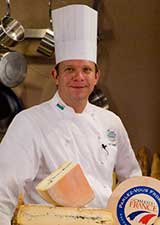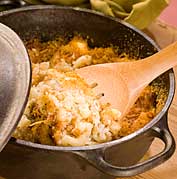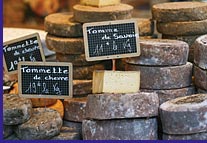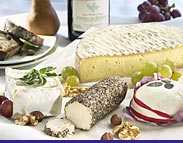“Comfort Cuisine” is Elegance with a Taste of Home

| Bleu Burger D’Ambert | Apple Pie A La Versaille With Triple Crème Ice Cream | Grilled Camembert Sandwiches with Summer Tomato Soup |
No matter what country you live in, comfort food is a cultural touchstone with perennial appeal. Comfort foods are the homemade dishes of childhood; they are easy to prepare and serve, and their basic ingredients seem imbued with the nurturing qualities of home and family. But while consumers enjoy returning to their favorite comfort foods, they seek dishes that provide something special, too — a touch of elegance at home. It prompted us to ask: how do you turn home cooking into “cuisine”? Well, you know the answer — French Cheese!
 Through a partnership with the Culinary Institute of America, one of the world’s premier culinary colleges, our inspiration was realized: take the most popular comfort food dishes in America and add the unexpected, savory taste of French Cheese. The extraordinary result was “Comfort Cuisine,” a catalog of recipes that elevates the essentials of American home cooking such as macaroni and cheese, burgers, casseroles, and desserts by using the spectrum of flavors offered by French Cheeses. Groundbreaking and delicious, these recipes capitalize on the current trend of cooking with fromage that has ignited the culinary world, and at the same time, they capture a taste of home.
Through a partnership with the Culinary Institute of America, one of the world’s premier culinary colleges, our inspiration was realized: take the most popular comfort food dishes in America and add the unexpected, savory taste of French Cheese. The extraordinary result was “Comfort Cuisine,” a catalog of recipes that elevates the essentials of American home cooking such as macaroni and cheese, burgers, casseroles, and desserts by using the spectrum of flavors offered by French Cheeses. Groundbreaking and delicious, these recipes capitalize on the current trend of cooking with fromage that has ignited the culinary world, and at the same time, they capture a taste of home.
“The cheeses offer a bit more of a complex taste for the basic American palate,” said Scott Samuel, an instructor at California’s CIA at Greystone and the chef charged with bringing the Comfort Cuisine concept to fruition. Samuel wrote each recipe in the Comfort Cuisine catalog from scratch and then tested and fine-tuned them in the kitchen to achieve the perfect presentation. His intention was to surprise the palate, provide a sense of familiarity, and highlight French Cheese flavors by reinventing American staples and reinvigorating the pleasant associations that these dishes provide.
His efforts led to some surprising combinations. One recipe features a hamburger topped with Fourme d’Ambert, a creamy, mild blue. The recommended drink pairing? A Coke. “Actually, that’s not our final pairing,” laughed Samuel. Though the soda pairing began as a joke, the impulse was right on target: accessibility is of primarily importance. Finding cheeses that are readily available, are “user-friendly,” and can assimilate with traditional dishes is part of what makes the Comfort Cuisine recipes a success.
 |
| Chef Scott Samuel |
Delivering popular food enlivened with the unexpected was a mission made for Samuel. He is known for pushing the envelope with new ingredients and new flavor combinations at restaurants like the innovative Brie & Bordeaux, The French Laundry, and the celebrated Herbfarm in Washington state. He enjoys creating dishes that he likes first and foremost, then finding customers willing to be adventurous enough to try them. Current trends in cooking suggest a return to the roots of cuisine by using local and seasonal ingredients that are presented in an adventurous way. Samuel cites the renowned Charlie Trotter, the iconoclastic David Chang, and his former mentor at The French Laundry, Thomas Keller, as top chefs famous for dishes that put a twist on basic ingredients. By joining the familiar and unfamiliar with Comfort Cuisine, Samuel continues to advance the notion that altering a simple dish can have exciting results.
One flavorful example is the Grilled Camembert Sandwich & Tomato Soup, which was inspired by an indispensable and easy-to-make lunchtime favorite. “Every summer when the tomatoes are perfect, I make a simple summer tomato soup and ultimately pair it with a grilled cheese sandwich,” said Samuel of the motivation behind creating this dish. For Comfort Cuisine, he re-envisioned the soup and sandwich concept and incorporated Camembert — a rich, melty crème cheese with blue notes, characteristics that make it perfect for this casual and consoling meal. “It’s an element of elegance on top of comfort,” he said, adding that Camembert is “one of the most user-friendly cheeses on the market. You can find it almost anywhere.” He uses simple white bread, freshened with a black pepper and olive oil, which he grills on either a panini grill or a sauté pan.
 |
| Petite Chèvre Pizza |
In creating the recipes, Samuel considered the dish in its entirety — its flavor, its texture, and its aroma — while considering what types of cheese pair well with the flavor profiles. “A lot of people might think of French Cheese as stinky cheese or just too rich,” he said. “They stay away from it because they don’t know enough about it, so I’m trying to incorporate cheeses that will compare to cheeses that they are used to — basic cheeses on the American shelf.” Comfort Cuisine recipes use primarily cow’s milk cheeses, which fit Samuel’s primary requirements of being user-friendly and available. However, goat’s milk has a prominent spot in the Goat Cheese Pizza, and Ossau-Iraty, a sheep’s milk cheese, is used in the Breakfast Frittata and Mac & Cheese recipes.
One of the challenges of using an ingredient known for its nuance was ensuring that its complex flavors would be enhanced, not lost. Samuel is careful not to let the cheeses overpower the rest of the ingredients. A Grilled Vegetable and Cheese Lasagna, because of its delicate vegetables, uses a cheese that has a nutty, grassy flavor that complements without dominating. Also, true to the French culture’s example of moderation, Samuel often uses less French Cheese in the recipes than he would the traditional counterparts. A Mac & Cheese that would ordinarily use a ½ lb of cheddar and ½ lb of Monterey Jack, for instance, instead uses 6 ounces of Cantal and 6 ounces of Tomme d'Alsace.
 |
| Bing Cherry Compote & Brillat Savarin |
The Apple Pie with Triple Crème ice cream recipe may be the most eclectic on the Comfort Cuisine list. Grated Mimolette — a firm, orange grating cheese — is used in the crust to provide a special touch of saltiness and nuttiness. For the inventive cheese-infused ice cream, any Triple Crème can be used, including Brie. Another unique dessert recipe, Caramel Chocolate Truffle, combines chocolate and cheese, a rich, delicious but unorthodox union. Samuel uses Fleur de Sel, bing cherry dried fruit compote, and a Triple Crème cheese, in this case, Saint André. “It’s intended to be very small, rich-on-rich, with little bit of sweetness to cut the richness,” he said. While the pairing is nontraditional, it represents a decadent nod to the traditional cheese course that in France customarily follows the meal.
 |
| Macaroni and Fromage Rustique |
The commitment to creating easy-to-execute dishes was second only to the commitment to taste, and Samuel knew he had been successful when he used some of his students in the testing process. “They said, you know, these are real simple recipes,” said Samuel. “You boil the macaroni, you make a little sauce, you include some different flavors in it, you highlight with a little sautéed bacon, and there you go.” The uncomplicated nature of the recipes caters to the consumer’s competing desires to get back to basics while still preserving a bit of pleasure. “That’s what is going on now in America. With the economy the way it is, people want to get back to their roots and to have something very simple,” said Samuel. “Anyone can look at these recipes and say, ‘I’ve seen these cheeses at Whole Foods, or at my local cheese store.’ And because the rest of the ingredients are things they always use, they’re apt to say, ‘Hey, let’s try it.’”






